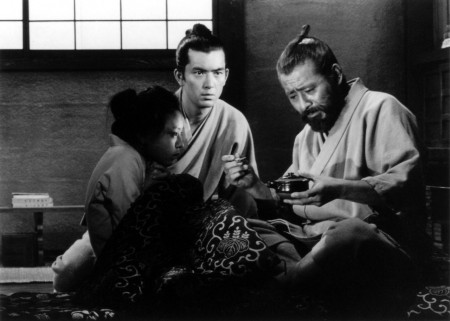Strange Moments in Solid Movies: Red Beard, Bringer of Pain and Painkillers
Akira Kurosawa’s Red Beard is a work of profound humanism, so much so that its titular character is generous enough to give center stage to those around him who really need it: the broken, the destitute, the disenchanted, and the dying. As overseer of everything in his medical facility in 19th century Edo (now Tokyo) for its impoverished citizens, the red-bearded Dr. KyojÅ Niide (ToshirÅ Mifune) observes what each inhabitant (staff and patients alike) requires to get better. Some need medication; others need meditation, as the past can weigh on the sick as much as present maladies. And a will to live–something that the poor could hardly fathom previously–can be more important for the less fortunate than fortuitous health. Although the events of the film undoubtedly revolve around Red Beard, it is his acquiescent disposition and charitable openness toward revolution (both narratively speaking and even in some ways subtly social) that give everyone else a chance to shine. These other characters–coming and going, improving and dying–are allotted a fair chance in the world for once; they are given liberty, which allows them to find some peace and comfort–true health, in any state.
The movie begins with the arrival of Dr. Noboru Yasumoto (YÅ«zÅ Kayama), a young physician who is finally getting some hands-on experience. Though initially arrogant and unhappy about his circumstance (he really wants to be the personal physician of the shogun–as far removed from caring for the poor as there could ever be), he discovers that working there is a transformative experience, due to his interactions with the patients–who, though physically sick, also deal with the mental and emotional deterioration caused by poverty, various abuses, and even romantic quandaries–and witnessing Red Beard in action. His selflessness and total devotion to the community is simply awe-inspiring. Though Red Beard can be a hard man to get along with, as he is obstinate and extremely motivated, he nevertheless wins Dr. Yasumoto (and the audience) over.
Red Beard is a down-to-earth saint. With no gloss, he’s an impressive man who is even willing to go to unseemly lengths for the good of his patients. When his facility is not getting the necessary funds–that is, when his own income cannot supplement the already limited funding–Red Beard begrudgingly uses confidential information he has against the society’s elites to get extra support. This questionable behavior is a necessary evil, leading to a greater good because it goes a long way to benefiting those who truly need the resources. Still, such a justification cannot quell his occasional disappointment with himself for having to get his hands dirty and his continual disdain for human injustices, but it’s precisely this dichotomy that makes Red Beard a fantastic character. And there is one moment in the movie that highlights this strange juncture, where he must go against ethical considerations in order to save a sick girl from a brothel by demolishing a horde of seedy men. Take a look (with no subtitles, unfortunately):
In an unprecedented action-filled scene, Red Beard not only fights a bunch criminals, he flat-out owns them. By using his medical knowledge perversely, he takes them apart, one by one, bone by cracked bone. But after it is all done, as he walks amongst the sprawled-out men, he fears that he has gone too far and wishes he had been more careful because a doctor is not supposed to hurt anyone. Red Beard then tells a man to fetch something to carry them away on, so they can be properly treated for their injuries. In doing so, He goes from doctor to fighter to doctor again, without missing a beat. And even though it may be abrupt, it is easy to understand why: his commitment to helping others is so unparalleled that he will protect individuals and potentially hurt those who stand in his way simultaneously. Now, it’s not like these men didn’t have it coming; they knew they were attacking a doctor who was trying to assist a little girl, but that feature still doesn’t justify Red Beard’s violent actions in his mind. Regardless of their shortcomings, the men are still men, and their brutal injuries could have been mitigated in some way. In turn, the fight scene amounts to something more than an action sequence (though, it is a definitely well orchestrated one); after all, the expression of Red Beard’s conflicted feelings as he moves through the wreckage takes up as much time as the fight itself, which reveals that it wasn’t purely entertaining because his actions obviously have consequences, and he is more than willing to face up to them. He’s a good doctor; it’s his job to take care of the ailing.
Additionally, Red Beard’s superior brawling skills suggests that going toe-to-toe with low-lives in order to help the lowly has happened before. And although he is certainly upset by the violence he has wrought, he is not shocked by it. As a veteran physician who frequents the poorer areas of Edo, he has probably experienced many dangerous predicaments. Searching out the troubled implies that he must also find trouble (though he obviously doesn’t go looking for it). In this regard, as paradoxical as this can be, his aptitude for self-defense shows his selflessness. His life is dedicated to preserving and bettering the well-beings of others. He is always working diligently at the hospital and aiding the sick outside of it. For this reason, defending others becomes synonymous with defending himself. And if he has to harm some men to save a girl, then he is prepared to do it just as he is prepared to take care of them after (a different kind of ‘taking care’ than what these criminals are used to hearing, no doubt). Red Beard is just that resolute; he’s an unbeatable character in another one of Kurosawa’s unbeatable movies.




